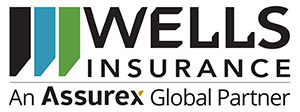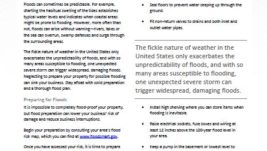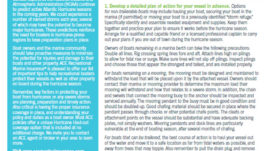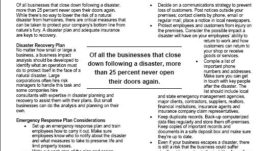Planning for Hurricanes. Of all businesses that close down following a disaster,
more than 25 percent never open their doors again.
While there’s no way to lower the risk of a natural
disaster from hurricanes, there are critical measures that
can be taken to protect your company’s bottom line from
nature’s fury. A disaster plan and adequate insurance
are keys to recovery.
Disaster Recovery Plan
No matter how small or large a
business, a business impact
analysis should be developed to
identify what an operation must
do to protect itself in the face of a
natural disaster. Large
corporations often hire risk
managers to handle this task and
some companies hire
consultants with expertise in disaster planning and
recovery to assist them with Planning for Hurricanes. But small
businesses can do the analysis and planning on their
own.
Emergency Response Plan Considerations
Set up an emergency response plan and train
employees how to carry it out. Make sure
employees know who to notify about the disaster
and what measures to take to preserve life and
limit property losses.
Write out each step of the plan and assign
responsibilities to employees in clear and simple
language. Practice the procedures set out in the
emergency response plan with regular,
scheduled drills.
Consider the things you may need initially during
the emergency. Do you need a back-up source
of power? Do you have a back-up
communications system?
Decide on a communications strategy to prevent
loss of customers. Post notices outside your
premises; contact clients by phone, email or
regular mail; place a notice in local newspapers.
Protect employees and customers from injury on
the premises. Consider the possible impact a
disaster will have on your employees’ ability to
return to work and how
customers can return to
your shop or receive
goods or services.
Compile a list of
important phone
numbers and addresses.
Make sure you can get
in touch with key people
after the disaster. The
list should include local
and state emergency management agencies,
major clients, contractors, suppliers, realtors,
financial institutions, insurance agents and
insurance company claim representatives.
Keep duplicate records. Back-up computerized
data files regularly and store them off-premises.
Keep copies of important records and
documents in a safe deposit box and make sure
they’re up to date.
Even if your business escapes a disaster, there
is still a risk that the business could suffer
significant losses due to the inability of suppliers
to deliver goods or services or a reduction in
customers. Businesses should communicate
with their suppliers and markets when Planning for Hurricanes (especially if
they are selling to a business as a supplier)
about their disaster preparedness and recovery
plans, so that everyone is prepared.
Protect your building. If you own the structure
that houses your business, integrate disaster protection for the building as well as the
contents into your plan. Consider the financial
impact if your business shuts down as a result of
a disaster. What would be the impact for a day,
a week or an entire revenue period?
Identify critical business activities and the
resources needed to support them. If you cannot
afford to shut down your operations, even
temporarily, determine what you require to run
the business at another location.
Find alternative facilities, equipment and
supplies, and locate qualified contractors.
Consider a reciprocity agreement with another
business. Try to get an advance commitment
from at least one contractor to respond to your
needs.
Protect computer systems and data. Data
storage firms offer off-site backups of computer
data that can be updated regularly via highspeed
modem or through the Internet.
Review Your Insurance Plan
Make sure you have sufficient coverage to pay for the
indirect costs of the disaster – the disruption to your
business – as well as the cost of repair or rebuilding.
Most policies do not cover flood or earthquake damage
and you may need to buy separate insurance for these
perils. Be sure you understand your policy deductibles
and limits when Planning for Hurricanes.
For a business, the costs of a disaster can extend
beyond the physical damage to the premises,
equipment, furniture and other business property.
There’s the potential loss of income while the premises
are unusable. Your disaster recovery should include a
detailed review of your insurance policies to ensure
there are no gaps in coverage. This includes property
insurance, business interruption insurance and extra
expense insurance. Even if your basic policy covers
expenses and loss of net business income, it may not
cover income interruptions due to damage that occurs
away from your premises, such as to your key customer
or supplier or to your utility company. You can generally
buy this additional coverage and add it to your existing
policy.
Most business owners are complacent about natural
disasters until it happens to them. It’s only when the
owner has gone through a disaster that a disaster plan,
including purchasing the proper insurance, is usually
considered.
Don’t let a lack of insurance coverage or poor planning
destroy your business. Contact Wells Insurance to learn
more about Planning for Hurricanes and to determine your best
insurance coverage needs.
Source: Insurance Information Institute.
-
 If I cash my check am I accepting that as the final amount?
If I cash my check am I accepting that as the final amount? -
 What should I expect after filing a claim?
What should I expect after filing a claim? -
 How storms in the Atlantic affect our ability to bind insurance policies.
How storms in the Atlantic affect our ability to bind insurance policies. -
 Pet Disaster Preparedness
Pet Disaster Preparedness -
 NFIP Flood Insurance FAQ
NFIP Flood Insurance FAQ -
 Emergency Financial First Aid Toolkit
Emergency Financial First Aid Toolkit -
 NC HurriClaims Toolkit
NC HurriClaims Toolkit -
 What is not covered in my homeowner's policy?
What is not covered in my homeowner's policy? -
 What is the first thing I should do if I have hurricane damage?
What is the first thing I should do if I have hurricane damage? -
 Understanding Your Flood Insurance Policy
Understanding Your Flood Insurance Policy -
 Preparing your Business for Flooding – Commercial Insurance
Preparing your Business for Flooding – Commercial Insurance -
 Hurricane Preparation Tips for Boaters
Hurricane Preparation Tips for Boaters -
 Hurricanes and Severe Storms – Marine Insurance
Hurricanes and Severe Storms – Marine Insurance -
 Advanced Planning for Hurricanes – Commercial Insurance
Advanced Planning for Hurricanes – Commercial Insurance -
 How to Prepare for a Hurricane – Home and Family
How to Prepare for a Hurricane – Home and Family















